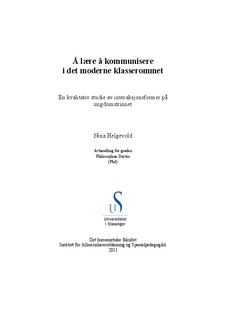| dc.description.abstract | The study seeks to analyse teaching and learning as communicative institutional
practices, and what conditions of learning and socialization that are study also argue that when students are participating in social practices where
cultural tools are made available, what is held as more traditional settings
appear as inclusive settings in the classroom.
offered students in the modern classroom through different communicative
practices. In Norway the Education Act of 1998, §1-3 states that the Norwegian
school system shall offer an adapted education for all students in accordance
to students’ abilities and qualifications. The same act, § 8-2 declares
that it is illegal to permanently organize students in different groups based
upon academic levels, gender or ethnicity. Equal, inclusive and adapted education
are overriding principles for the Norwegian school (Culture for Learning,
White paper nr.30, 2003-2004). That means that education should be
accessible to everyone, and that every student should be given optimal opportunities
for learning, mastering and personal development.
The study draws on sociocultural perspectives on development and learning.
Humans act within the framework of cultural and practical practices or stated
in another way, human thinking and acting is situated within social contexts
(Säljö, 2001; Wertsch, 1998). Preliminary research questions were concerned
with what processes of knowledge transformation we find in a lowersecondary
classroom and how these knowledge transformations are organized
in time and space. The project has focused upon cultural conceptions about
learning, teaching and knowledge that are communicated through structures
and interactions in the classroom, how students are engaged in different processes
of knowledge appropriation, what cultural tools are at hand and how
these have been used.
In the modern classroom interactions are “caught in the middle” between two
different educational settings in the classroom. These two settings can be described
as a teacher dominant setting or a student dominant setting. These two
settings can also be described in terms of a collective setting and an individualized
setting. The study explores these two settings and what conditions these
settings offer as contexts for students learning and socialization in the classroom.
The study questions conditions for learning and socialization that are
offered students in an individualized setting in the modern classroom, and
argues that this setting excludes students from participation. Findings in this | en_US |
